Organizational Behavior: Addressing the Aging Workforce Challenges
VerifiedAdded on 2022/09/15
|7
|1758
|19
Essay
AI Summary
This essay examines the significant implications of an aging workforce on organizational behavior, drawing from academic sources to analyze key challenges and opportunities. The discussion begins by addressing motivation, highlighting the positive correlation between intrinsic motivation and age, as well as the importance of creating a supportive work environment that recognizes the experience and contributions of older workers. The essay then delves into leadership styles, exploring how transformational and contingency approaches can be adapted to effectively manage and empower older employees. Furthermore, the paper investigates the interplay of power dynamics and leadership, emphasizing the need for leaders to foster positive relationships and adapt their approaches to suit the needs of an aging workforce. Finally, the essay considers work design strategies, advocating for flexible work arrangements and stress management initiatives to enhance employee well-being and retention. The paper concludes by emphasizing the importance of implementing age management strategies to create a healthy work environment, retain talent, and foster innovation.
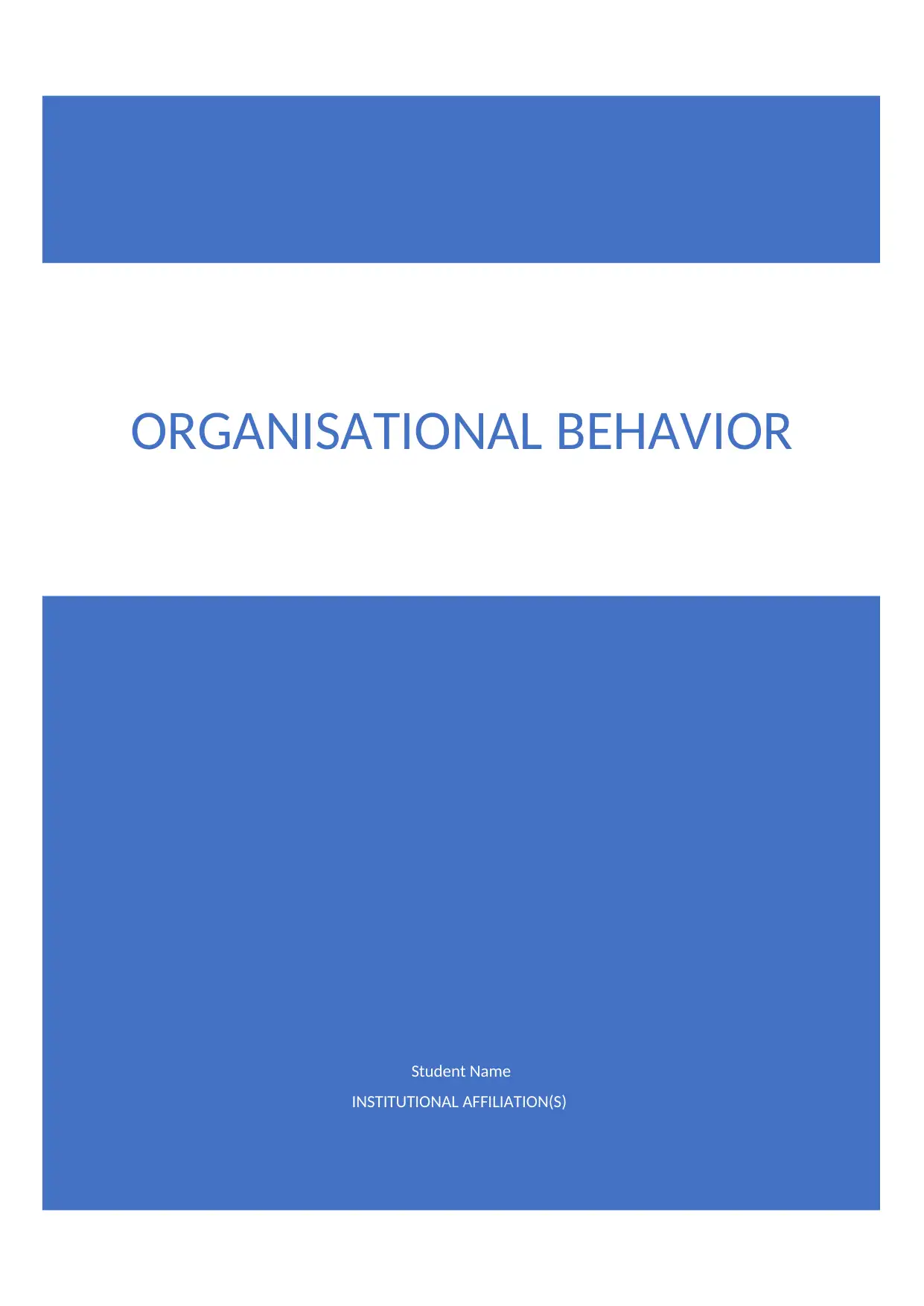
Student Name
INSTITUTIONAL AFFILIATION(S)
ORGANISATIONAL BEHAVIOR
INSTITUTIONAL AFFILIATION(S)
ORGANISATIONAL BEHAVIOR
Paraphrase This Document
Need a fresh take? Get an instant paraphrase of this document with our AI Paraphraser
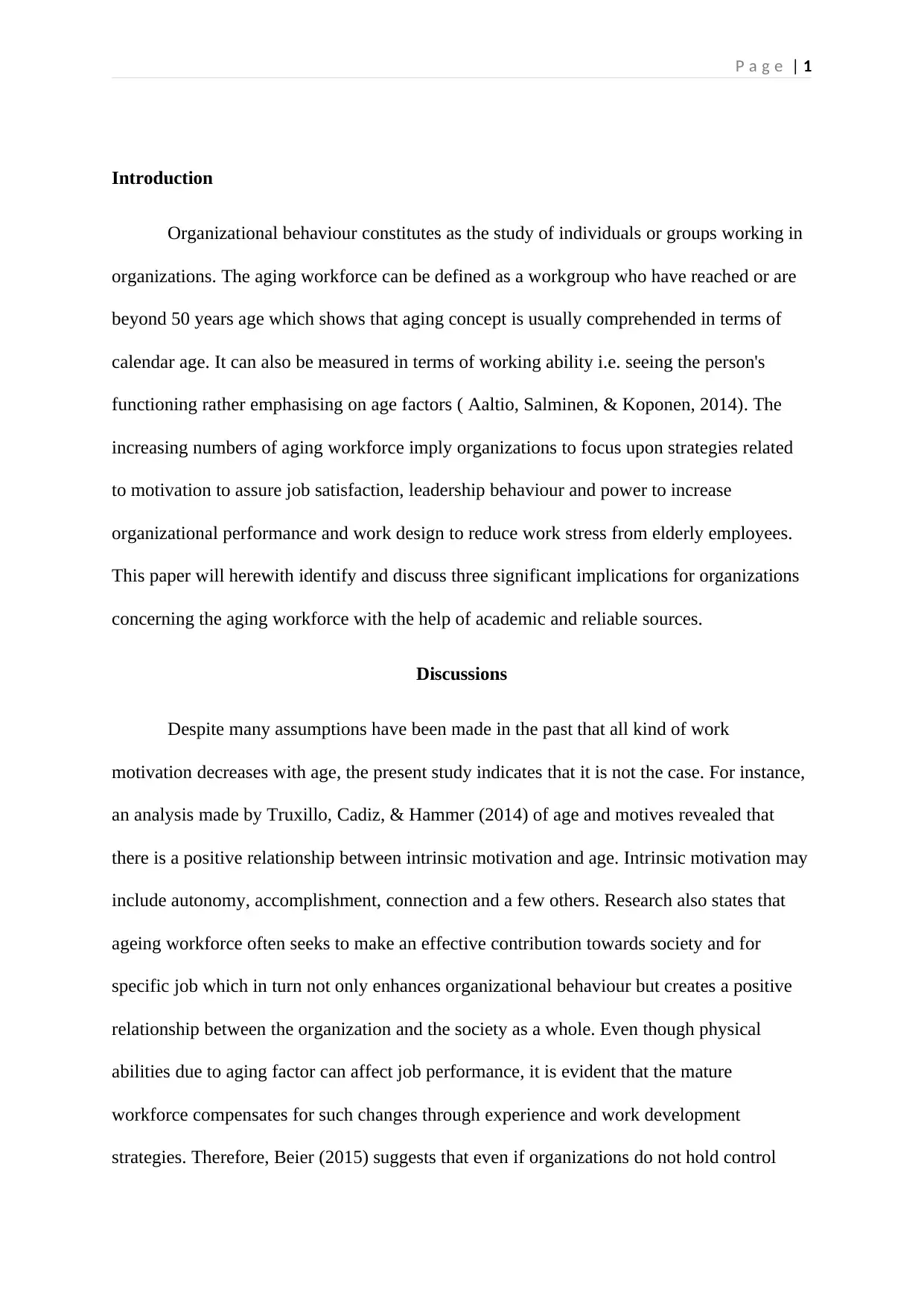
P a g e | 1
Introduction
Organizational behaviour constitutes as the study of individuals or groups working in
organizations. The aging workforce can be defined as a workgroup who have reached or are
beyond 50 years age which shows that aging concept is usually comprehended in terms of
calendar age. It can also be measured in terms of working ability i.e. seeing the person's
functioning rather emphasising on age factors ( Aaltio, Salminen, & Koponen, 2014). The
increasing numbers of aging workforce imply organizations to focus upon strategies related
to motivation to assure job satisfaction, leadership behaviour and power to increase
organizational performance and work design to reduce work stress from elderly employees.
This paper will herewith identify and discuss three significant implications for organizations
concerning the aging workforce with the help of academic and reliable sources.
Discussions
Despite many assumptions have been made in the past that all kind of work
motivation decreases with age, the present study indicates that it is not the case. For instance,
an analysis made by Truxillo, Cadiz, & Hammer (2014) of age and motives revealed that
there is a positive relationship between intrinsic motivation and age. Intrinsic motivation may
include autonomy, accomplishment, connection and a few others. Research also states that
ageing workforce often seeks to make an effective contribution towards society and for
specific job which in turn not only enhances organizational behaviour but creates a positive
relationship between the organization and the society as a whole. Even though physical
abilities due to aging factor can affect job performance, it is evident that the mature
workforce compensates for such changes through experience and work development
strategies. Therefore, Beier (2015) suggests that even if organizations do not hold control
Introduction
Organizational behaviour constitutes as the study of individuals or groups working in
organizations. The aging workforce can be defined as a workgroup who have reached or are
beyond 50 years age which shows that aging concept is usually comprehended in terms of
calendar age. It can also be measured in terms of working ability i.e. seeing the person's
functioning rather emphasising on age factors ( Aaltio, Salminen, & Koponen, 2014). The
increasing numbers of aging workforce imply organizations to focus upon strategies related
to motivation to assure job satisfaction, leadership behaviour and power to increase
organizational performance and work design to reduce work stress from elderly employees.
This paper will herewith identify and discuss three significant implications for organizations
concerning the aging workforce with the help of academic and reliable sources.
Discussions
Despite many assumptions have been made in the past that all kind of work
motivation decreases with age, the present study indicates that it is not the case. For instance,
an analysis made by Truxillo, Cadiz, & Hammer (2014) of age and motives revealed that
there is a positive relationship between intrinsic motivation and age. Intrinsic motivation may
include autonomy, accomplishment, connection and a few others. Research also states that
ageing workforce often seeks to make an effective contribution towards society and for
specific job which in turn not only enhances organizational behaviour but creates a positive
relationship between the organization and the society as a whole. Even though physical
abilities due to aging factor can affect job performance, it is evident that the mature
workforce compensates for such changes through experience and work development
strategies. Therefore, Beier (2015) suggests that even if organizations do not hold control
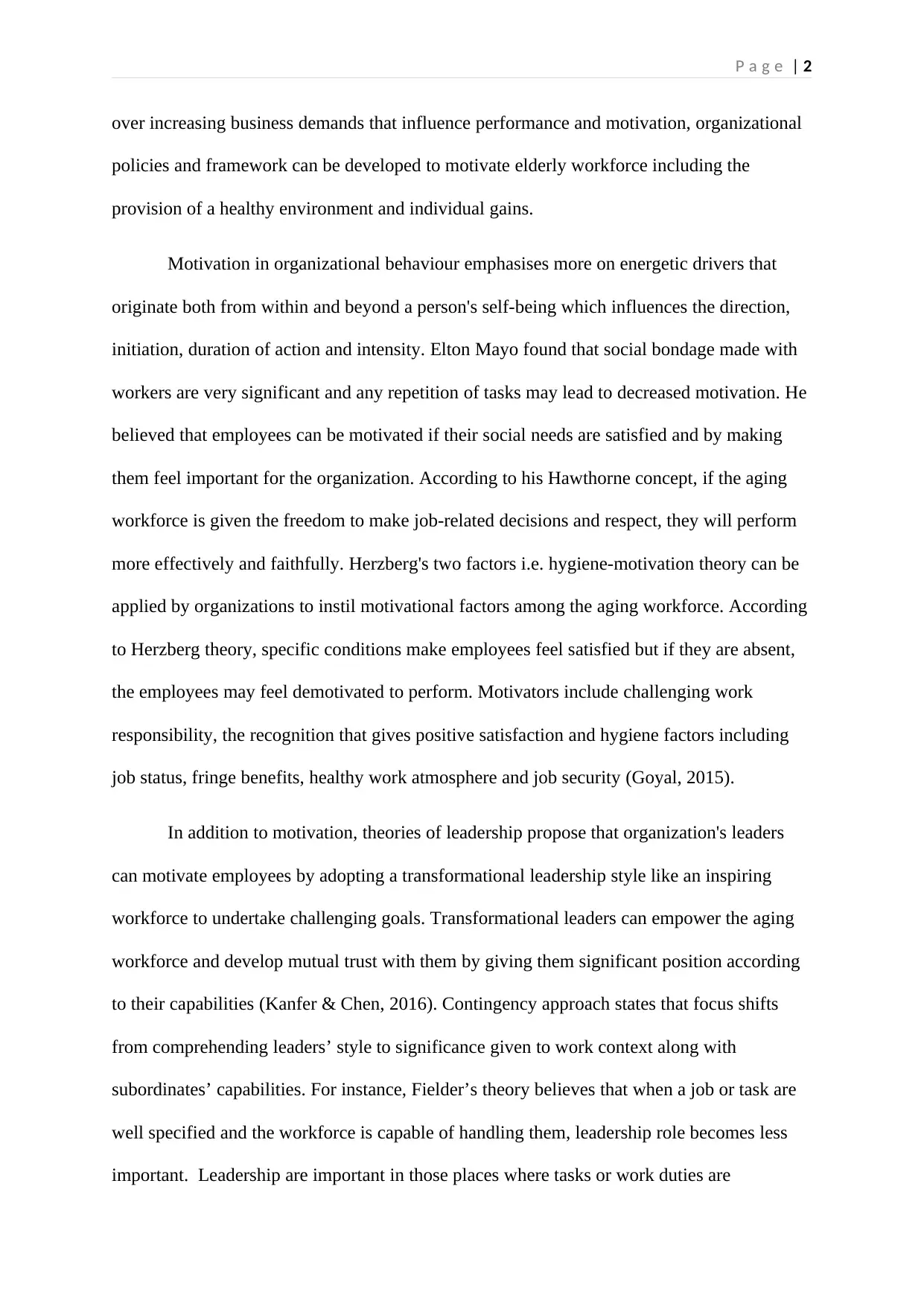
P a g e | 2
over increasing business demands that influence performance and motivation, organizational
policies and framework can be developed to motivate elderly workforce including the
provision of a healthy environment and individual gains.
Motivation in organizational behaviour emphasises more on energetic drivers that
originate both from within and beyond a person's self-being which influences the direction,
initiation, duration of action and intensity. Elton Mayo found that social bondage made with
workers are very significant and any repetition of tasks may lead to decreased motivation. He
believed that employees can be motivated if their social needs are satisfied and by making
them feel important for the organization. According to his Hawthorne concept, if the aging
workforce is given the freedom to make job-related decisions and respect, they will perform
more effectively and faithfully. Herzberg's two factors i.e. hygiene-motivation theory can be
applied by organizations to instil motivational factors among the aging workforce. According
to Herzberg theory, specific conditions make employees feel satisfied but if they are absent,
the employees may feel demotivated to perform. Motivators include challenging work
responsibility, the recognition that gives positive satisfaction and hygiene factors including
job status, fringe benefits, healthy work atmosphere and job security (Goyal, 2015).
In addition to motivation, theories of leadership propose that organization's leaders
can motivate employees by adopting a transformational leadership style like an inspiring
workforce to undertake challenging goals. Transformational leaders can empower the aging
workforce and develop mutual trust with them by giving them significant position according
to their capabilities (Kanfer & Chen, 2016). Contingency approach states that focus shifts
from comprehending leaders’ style to significance given to work context along with
subordinates’ capabilities. For instance, Fielder’s theory believes that when a job or task are
well specified and the workforce is capable of handling them, leadership role becomes less
important. Leadership are important in those places where tasks or work duties are
over increasing business demands that influence performance and motivation, organizational
policies and framework can be developed to motivate elderly workforce including the
provision of a healthy environment and individual gains.
Motivation in organizational behaviour emphasises more on energetic drivers that
originate both from within and beyond a person's self-being which influences the direction,
initiation, duration of action and intensity. Elton Mayo found that social bondage made with
workers are very significant and any repetition of tasks may lead to decreased motivation. He
believed that employees can be motivated if their social needs are satisfied and by making
them feel important for the organization. According to his Hawthorne concept, if the aging
workforce is given the freedom to make job-related decisions and respect, they will perform
more effectively and faithfully. Herzberg's two factors i.e. hygiene-motivation theory can be
applied by organizations to instil motivational factors among the aging workforce. According
to Herzberg theory, specific conditions make employees feel satisfied but if they are absent,
the employees may feel demotivated to perform. Motivators include challenging work
responsibility, the recognition that gives positive satisfaction and hygiene factors including
job status, fringe benefits, healthy work atmosphere and job security (Goyal, 2015).
In addition to motivation, theories of leadership propose that organization's leaders
can motivate employees by adopting a transformational leadership style like an inspiring
workforce to undertake challenging goals. Transformational leaders can empower the aging
workforce and develop mutual trust with them by giving them significant position according
to their capabilities (Kanfer & Chen, 2016). Contingency approach states that focus shifts
from comprehending leaders’ style to significance given to work context along with
subordinates’ capabilities. For instance, Fielder’s theory believes that when a job or task are
well specified and the workforce is capable of handling them, leadership role becomes less
important. Leadership are important in those places where tasks or work duties are
⊘ This is a preview!⊘
Do you want full access?
Subscribe today to unlock all pages.

Trusted by 1+ million students worldwide
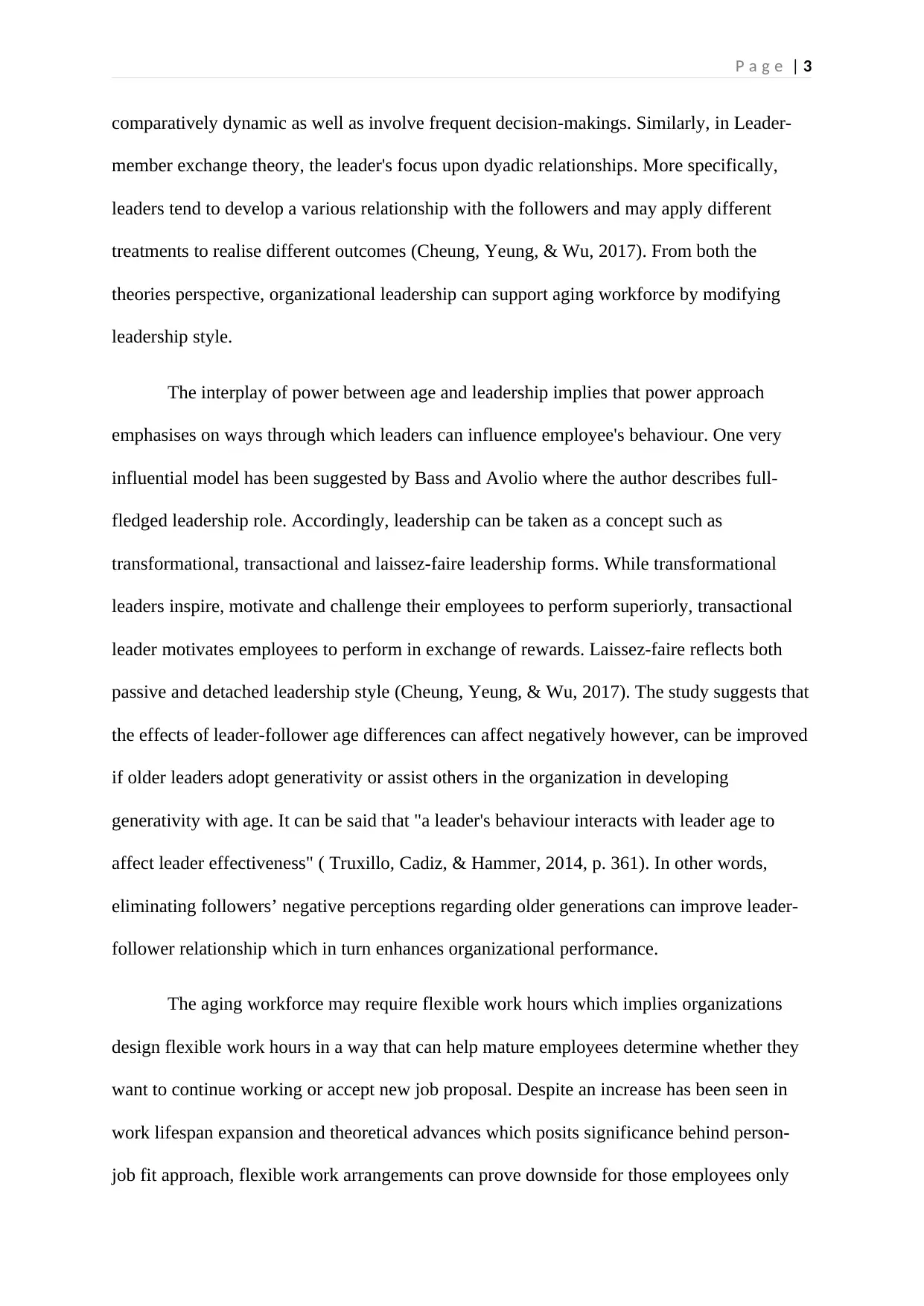
P a g e | 3
comparatively dynamic as well as involve frequent decision-makings. Similarly, in Leader-
member exchange theory, the leader's focus upon dyadic relationships. More specifically,
leaders tend to develop a various relationship with the followers and may apply different
treatments to realise different outcomes (Cheung, Yeung, & Wu, 2017). From both the
theories perspective, organizational leadership can support aging workforce by modifying
leadership style.
The interplay of power between age and leadership implies that power approach
emphasises on ways through which leaders can influence employee's behaviour. One very
influential model has been suggested by Bass and Avolio where the author describes full-
fledged leadership role. Accordingly, leadership can be taken as a concept such as
transformational, transactional and laissez-faire leadership forms. While transformational
leaders inspire, motivate and challenge their employees to perform superiorly, transactional
leader motivates employees to perform in exchange of rewards. Laissez-faire reflects both
passive and detached leadership style (Cheung, Yeung, & Wu, 2017). The study suggests that
the effects of leader-follower age differences can affect negatively however, can be improved
if older leaders adopt generativity or assist others in the organization in developing
generativity with age. It can be said that "a leader's behaviour interacts with leader age to
affect leader effectiveness" ( Truxillo, Cadiz, & Hammer, 2014, p. 361). In other words,
eliminating followers’ negative perceptions regarding older generations can improve leader-
follower relationship which in turn enhances organizational performance.
The aging workforce may require flexible work hours which implies organizations
design flexible work hours in a way that can help mature employees determine whether they
want to continue working or accept new job proposal. Despite an increase has been seen in
work lifespan expansion and theoretical advances which posits significance behind person-
job fit approach, flexible work arrangements can prove downside for those employees only
comparatively dynamic as well as involve frequent decision-makings. Similarly, in Leader-
member exchange theory, the leader's focus upon dyadic relationships. More specifically,
leaders tend to develop a various relationship with the followers and may apply different
treatments to realise different outcomes (Cheung, Yeung, & Wu, 2017). From both the
theories perspective, organizational leadership can support aging workforce by modifying
leadership style.
The interplay of power between age and leadership implies that power approach
emphasises on ways through which leaders can influence employee's behaviour. One very
influential model has been suggested by Bass and Avolio where the author describes full-
fledged leadership role. Accordingly, leadership can be taken as a concept such as
transformational, transactional and laissez-faire leadership forms. While transformational
leaders inspire, motivate and challenge their employees to perform superiorly, transactional
leader motivates employees to perform in exchange of rewards. Laissez-faire reflects both
passive and detached leadership style (Cheung, Yeung, & Wu, 2017). The study suggests that
the effects of leader-follower age differences can affect negatively however, can be improved
if older leaders adopt generativity or assist others in the organization in developing
generativity with age. It can be said that "a leader's behaviour interacts with leader age to
affect leader effectiveness" ( Truxillo, Cadiz, & Hammer, 2014, p. 361). In other words,
eliminating followers’ negative perceptions regarding older generations can improve leader-
follower relationship which in turn enhances organizational performance.
The aging workforce may require flexible work hours which implies organizations
design flexible work hours in a way that can help mature employees determine whether they
want to continue working or accept new job proposal. Despite an increase has been seen in
work lifespan expansion and theoretical advances which posits significance behind person-
job fit approach, flexible work arrangements can prove downside for those employees only
Paraphrase This Document
Need a fresh take? Get an instant paraphrase of this document with our AI Paraphraser
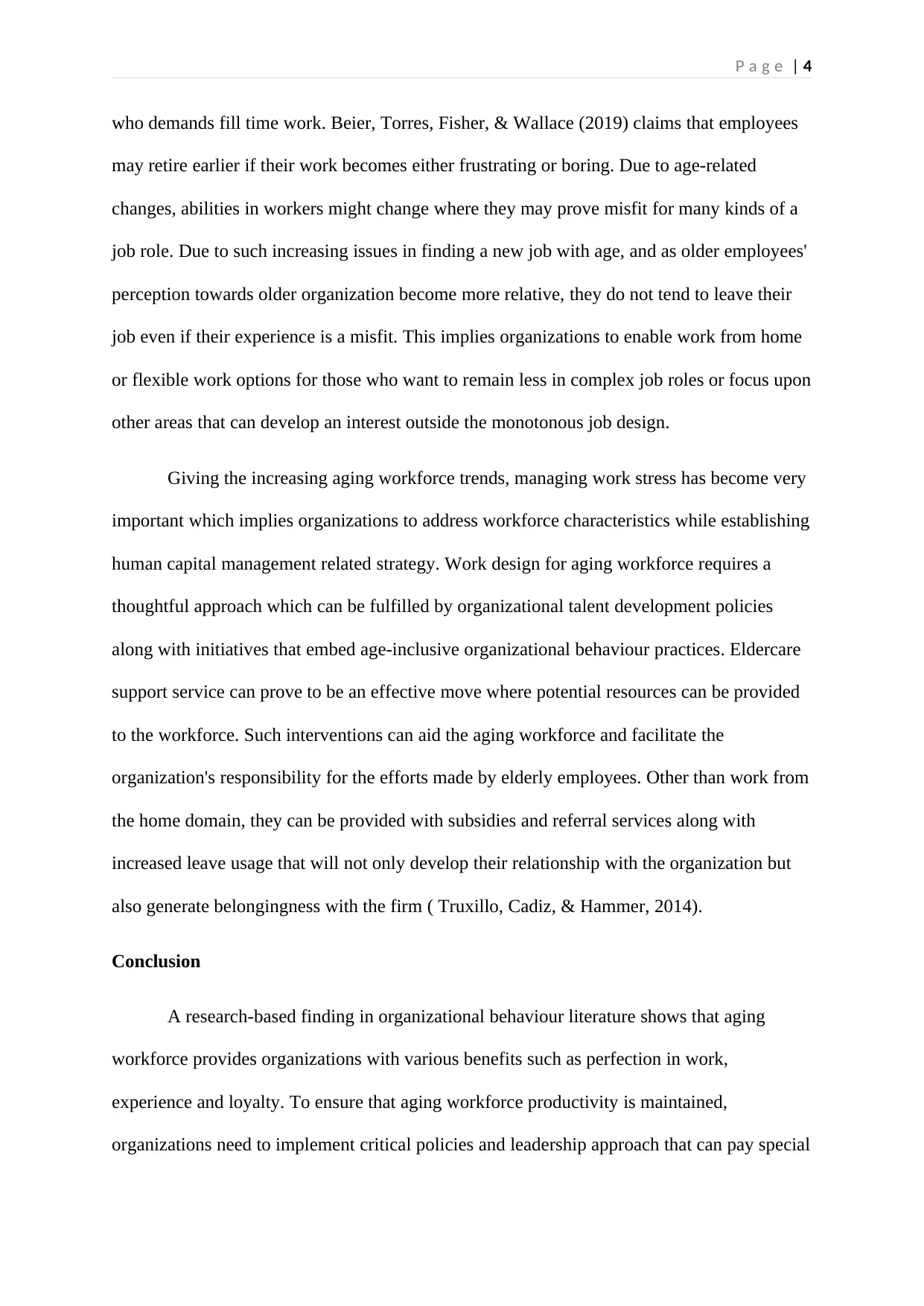
P a g e | 4
who demands fill time work. Beier, Torres, Fisher, & Wallace (2019) claims that employees
may retire earlier if their work becomes either frustrating or boring. Due to age-related
changes, abilities in workers might change where they may prove misfit for many kinds of a
job role. Due to such increasing issues in finding a new job with age, and as older employees'
perception towards older organization become more relative, they do not tend to leave their
job even if their experience is a misfit. This implies organizations to enable work from home
or flexible work options for those who want to remain less in complex job roles or focus upon
other areas that can develop an interest outside the monotonous job design.
Giving the increasing aging workforce trends, managing work stress has become very
important which implies organizations to address workforce characteristics while establishing
human capital management related strategy. Work design for aging workforce requires a
thoughtful approach which can be fulfilled by organizational talent development policies
along with initiatives that embed age-inclusive organizational behaviour practices. Eldercare
support service can prove to be an effective move where potential resources can be provided
to the workforce. Such interventions can aid the aging workforce and facilitate the
organization's responsibility for the efforts made by elderly employees. Other than work from
the home domain, they can be provided with subsidies and referral services along with
increased leave usage that will not only develop their relationship with the organization but
also generate belongingness with the firm ( Truxillo, Cadiz, & Hammer, 2014).
Conclusion
A research-based finding in organizational behaviour literature shows that aging
workforce provides organizations with various benefits such as perfection in work,
experience and loyalty. To ensure that aging workforce productivity is maintained,
organizations need to implement critical policies and leadership approach that can pay special
who demands fill time work. Beier, Torres, Fisher, & Wallace (2019) claims that employees
may retire earlier if their work becomes either frustrating or boring. Due to age-related
changes, abilities in workers might change where they may prove misfit for many kinds of a
job role. Due to such increasing issues in finding a new job with age, and as older employees'
perception towards older organization become more relative, they do not tend to leave their
job even if their experience is a misfit. This implies organizations to enable work from home
or flexible work options for those who want to remain less in complex job roles or focus upon
other areas that can develop an interest outside the monotonous job design.
Giving the increasing aging workforce trends, managing work stress has become very
important which implies organizations to address workforce characteristics while establishing
human capital management related strategy. Work design for aging workforce requires a
thoughtful approach which can be fulfilled by organizational talent development policies
along with initiatives that embed age-inclusive organizational behaviour practices. Eldercare
support service can prove to be an effective move where potential resources can be provided
to the workforce. Such interventions can aid the aging workforce and facilitate the
organization's responsibility for the efforts made by elderly employees. Other than work from
the home domain, they can be provided with subsidies and referral services along with
increased leave usage that will not only develop their relationship with the organization but
also generate belongingness with the firm ( Truxillo, Cadiz, & Hammer, 2014).
Conclusion
A research-based finding in organizational behaviour literature shows that aging
workforce provides organizations with various benefits such as perfection in work,
experience and loyalty. To ensure that aging workforce productivity is maintained,
organizations need to implement critical policies and leadership approach that can pay special
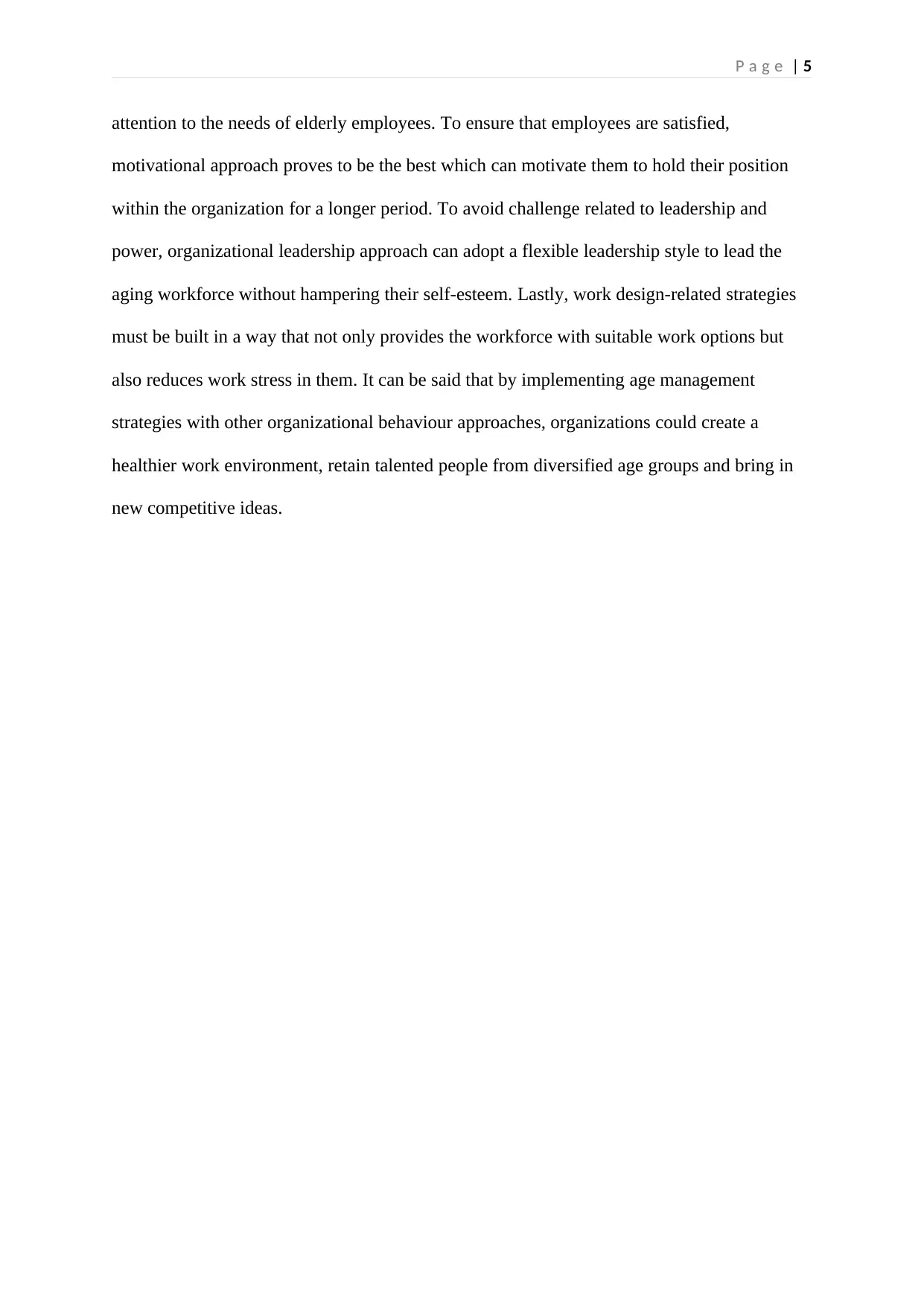
P a g e | 5
attention to the needs of elderly employees. To ensure that employees are satisfied,
motivational approach proves to be the best which can motivate them to hold their position
within the organization for a longer period. To avoid challenge related to leadership and
power, organizational leadership approach can adopt a flexible leadership style to lead the
aging workforce without hampering their self-esteem. Lastly, work design-related strategies
must be built in a way that not only provides the workforce with suitable work options but
also reduces work stress in them. It can be said that by implementing age management
strategies with other organizational behaviour approaches, organizations could create a
healthier work environment, retain talented people from diversified age groups and bring in
new competitive ideas.
attention to the needs of elderly employees. To ensure that employees are satisfied,
motivational approach proves to be the best which can motivate them to hold their position
within the organization for a longer period. To avoid challenge related to leadership and
power, organizational leadership approach can adopt a flexible leadership style to lead the
aging workforce without hampering their self-esteem. Lastly, work design-related strategies
must be built in a way that not only provides the workforce with suitable work options but
also reduces work stress in them. It can be said that by implementing age management
strategies with other organizational behaviour approaches, organizations could create a
healthier work environment, retain talented people from diversified age groups and bring in
new competitive ideas.
⊘ This is a preview!⊘
Do you want full access?
Subscribe today to unlock all pages.

Trusted by 1+ million students worldwide
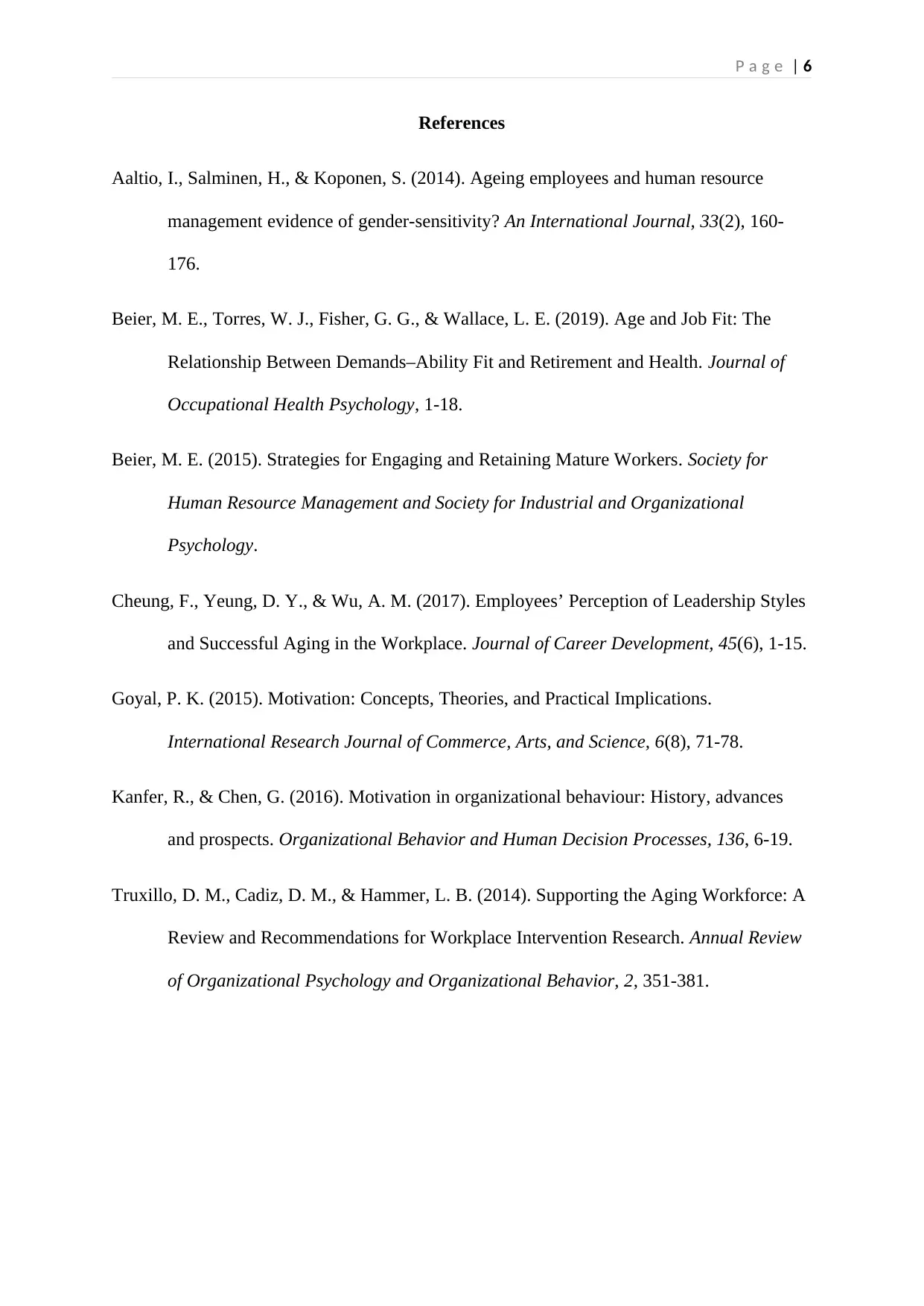
P a g e | 6
References
Aaltio, I., Salminen, H., & Koponen, S. (2014). Ageing employees and human resource
management evidence of gender-sensitivity? An International Journal, 33(2), 160-
176.
Beier, M. E., Torres, W. J., Fisher, G. G., & Wallace, L. E. (2019). Age and Job Fit: The
Relationship Between Demands–Ability Fit and Retirement and Health. Journal of
Occupational Health Psychology, 1-18.
Beier, M. E. (2015). Strategies for Engaging and Retaining Mature Workers. Society for
Human Resource Management and Society for Industrial and Organizational
Psychology.
Cheung, F., Yeung, D. Y., & Wu, A. M. (2017). Employees’ Perception of Leadership Styles
and Successful Aging in the Workplace. Journal of Career Development, 45(6), 1-15.
Goyal, P. K. (2015). Motivation: Concepts, Theories, and Practical Implications.
International Research Journal of Commerce, Arts, and Science, 6(8), 71-78.
Kanfer, R., & Chen, G. (2016). Motivation in organizational behaviour: History, advances
and prospects. Organizational Behavior and Human Decision Processes, 136, 6-19.
Truxillo, D. M., Cadiz, D. M., & Hammer, L. B. (2014). Supporting the Aging Workforce: A
Review and Recommendations for Workplace Intervention Research. Annual Review
of Organizational Psychology and Organizational Behavior, 2, 351-381.
References
Aaltio, I., Salminen, H., & Koponen, S. (2014). Ageing employees and human resource
management evidence of gender-sensitivity? An International Journal, 33(2), 160-
176.
Beier, M. E., Torres, W. J., Fisher, G. G., & Wallace, L. E. (2019). Age and Job Fit: The
Relationship Between Demands–Ability Fit and Retirement and Health. Journal of
Occupational Health Psychology, 1-18.
Beier, M. E. (2015). Strategies for Engaging and Retaining Mature Workers. Society for
Human Resource Management and Society for Industrial and Organizational
Psychology.
Cheung, F., Yeung, D. Y., & Wu, A. M. (2017). Employees’ Perception of Leadership Styles
and Successful Aging in the Workplace. Journal of Career Development, 45(6), 1-15.
Goyal, P. K. (2015). Motivation: Concepts, Theories, and Practical Implications.
International Research Journal of Commerce, Arts, and Science, 6(8), 71-78.
Kanfer, R., & Chen, G. (2016). Motivation in organizational behaviour: History, advances
and prospects. Organizational Behavior and Human Decision Processes, 136, 6-19.
Truxillo, D. M., Cadiz, D. M., & Hammer, L. B. (2014). Supporting the Aging Workforce: A
Review and Recommendations for Workplace Intervention Research. Annual Review
of Organizational Psychology and Organizational Behavior, 2, 351-381.
1 out of 7
Related Documents
Your All-in-One AI-Powered Toolkit for Academic Success.
+13062052269
info@desklib.com
Available 24*7 on WhatsApp / Email
![[object Object]](/_next/static/media/star-bottom.7253800d.svg)
Unlock your academic potential
Copyright © 2020–2025 A2Z Services. All Rights Reserved. Developed and managed by ZUCOL.




